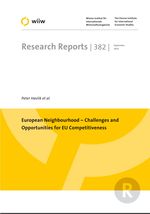European Neighbourhood - Challenges and Opportunities for EU Competitiveness
Vasily Astrov, Peter Havlik, Mario Holzner, Gabor Hunya, Isilda Mara, Sandor Richter, Roman Stöllinger and Hermine Vidovic
wiiw Research Report No. 382, September 2012
154 pages including 24 Tables and 61 Figures
(Report based on Background Study for European Competitiveness Report 2012, see http://ec.europa.eu/enterprise/policies/industrial-competitiveness/competitiveness-analysis/european-competitiveness-report/index_en.htm)
Summary
Countries belonging to the European neighbourhood are highly diverse. Their diversity is multidimensional (geographical, socio-economic, political, cultural, religious, etc.) and the individual dimensions all have important implications for EU policies towards the region(s), for EU institutional relations with individual neighbourhood countries and for these countries themselves – including their competitiveness. After mapping the economic situation and the competitiveness of the countries in European neighbourhood, the paper proceeds to an analysis of the selected aspects of these countries’ competitiveness:
- The economic impacts of existing agreements between EU Member States and neighbouring countries. A simulation of various scenarios covering free trade in goods between the EU and some of its neighbours is attempted.
- Where possible, the effects of bilateral agreements on the growth and productivity of small and medium-sized enterprises (SMEs) in the Rim countries are investigated.
- The economic impact and the impact on competitiveness of migration and remittances flows between Rim countries and EU Member States are investigated, as is the effect these have on the labour market.
- Conclusions are drawn and policy recommendations made on the basis of the analysis; these cover the challenges and opportunities for the competitiveness of EU enterprises and sectors in the neighbouring countries.
Keywords: European Union, EU Neighbourhood, competitiveness, foreign trade, FDI, labour market, migration, remittances
JEL classification: D60, E2, F15, F21, F22, F55
Countries covered: Albania, Algeria, Armenia, Azerbaijan, Belarus, Bosnia and Herzegovina, Egypt, European Union, Georgia, Jordan, Kosovo, Lebanon, Libya, Moldova, Morocco, Norway, Russia, Serbia, Switzerland, Syria, Tunisia, Ukraine, Israel, Liechtenstein, the Palestinian Authority
Research Areas: Labour, Migration and Income Distribution, International Trade, Competitiveness and FDI
